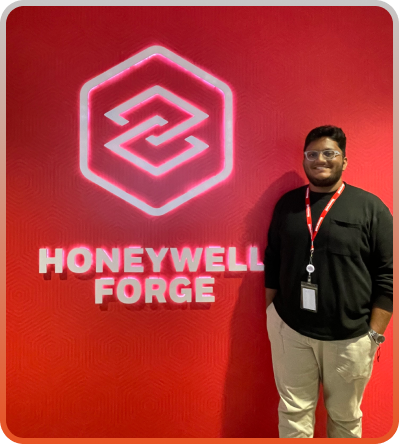top of page

User Experience Designer
2023
Honeywell Forge UX Team
Summary

I was part of the Honeywell Performance+ UX team as a User Experience Designer. My main focus was improving the user experience of the Workforce Intelligence module. I took the lead in designing the Notifications feature for this module and helped establish practical guidelines for its implementation. This involved creating a clear plan from start to finish and ensuring everyone understood how to apply it effectively across the product.

Jhordan
Me
Julie
Coco
Maria
My Impact
The notification designs I meticulously crafted are poised to be integrated into upcoming design iterations. The framework I developed serves as a foundational tool that will streamline notification implementation across all modules within the Performance+ product suite. This contribution ensures a consistent and user-centric approach to notification design, enhancing end-users overall usability and efficiency.




The full scope of this project is under NDA
The case study overviews my impact, contributions, and learnings as a designer. For additional information on the project please contact me directly
Overview of the product
" Distribution centers require dozens of independent systems to operate, which creates complexity, hinders valuable reporting and analysis, and make remote management impossible. The future of distribution centre operations is this enterprise performance management solutions that offer a single system of record to maximize asset health and availability, driving real-world improvements in sustainability, operations and worker experience.
Honeywell Forge Connected Warehouse enables intelligent operations for retails warehouses and helps distribution centers stay on plan amidst the chaos by orchestrating the multitude of assets, labor, and inventory when unexpected spikes of failures occur."

A quick overview of the things I took the lead on.
The problem
Supervisors need to stay informed of new incidents and changes in task status in the warehouse, while workers need to track their task assignments. The question becomes:
How can we effectively leverage notifications to provide important information, guidance, and actions regarding incidents and tasks?
Ground research to identify the project ‘ingredients’.
I delved into understanding the complexities of warehouse operations. This involved a meticulous exploration of different warehouse areas and personas, alongside an in-depth assessment of existing workflows. To gain a comprehensive understanding, I meticulously analyzed research documentation, and project briefs, and conducted secondary research. Additionally, I undertook desk research to uncover established patterns and best practices for notifications in similar contexts.
How was the ‘prep’ done?
To lay the groundwork for the project, I synthesized the gathered information and identified crucial components for the incident and task management workflow. This included categorizing event types based on thorough events management research and familiarizing myself with various design patterns for notifications, such as Toast, Banner, In-app, and Push.



An overview of how an incident is handled at a warehouse.
In the implementation phase, I developed comprehensive guidelines for notifications, covering their usage, behavior, types, lock screen appearance, style, and templates. Moreover, I created a detailed workflow for incident and task management, pinpointing opportune moments for integrating notifications effectively. To ensure scalability and consistency, I also devised a notification framework, serving as a blueprint for future notification development across different modules.

Some things that didn’t work out
During this phase, I conducted design feedback workshops with the UX Team to gather insights and refine the wireframes. After completing the research phase, I prepared an initial draft of wireframes to guide our discussions. However, during the workshops, it became apparent that the information items used in the wireframes lacked sufficient research backing. This realization prompted us to reevaluate our approach and make necessary adjustments to ensure alignment with user needs and design rationale. The feedback I collected from the workshops is listed below.
☑️ The button for variant 1 might be too small for people with large hands.
🤔 I'd also think about how multiple notifications might stack together, how would that affect user interactions with the buttons?
🙄 I don't like not having the actions because user may just ignore the notification
🤔 How are we letting the user know the difference between an incident and a task?
... and more.
Tackling the hiccups in the project
To overcome challenges, I adapted my research approach to include a collaborative card sorting exercise on UserTesting. This allowed for a more inclusive and insightful exploration of necessary notification information for both worker and supervisor personas, ensuring a more robust foundation for design decisions.
✅ Engaged in the activity with five participants for each persona.
✅ Participants selected and organized information based on their needs according to scenarios.

The improvements in the approach

Following the activity on Usertesting.com, I identified critical information items required for notifications and used this insight to refine wireframes. Collaborating with subject matter experts and designers, I conducted workshops to review the wireframes, leveraging activities like the Rose, Thorn, and Bud exercise and Dot voting to gather qualitative and quantitative feedback, ensuring iterative improvements.
The Final Designs





Please contact me directly as the full scope is under NDA.
For additional information on the project's details and outcomes
bottom of page